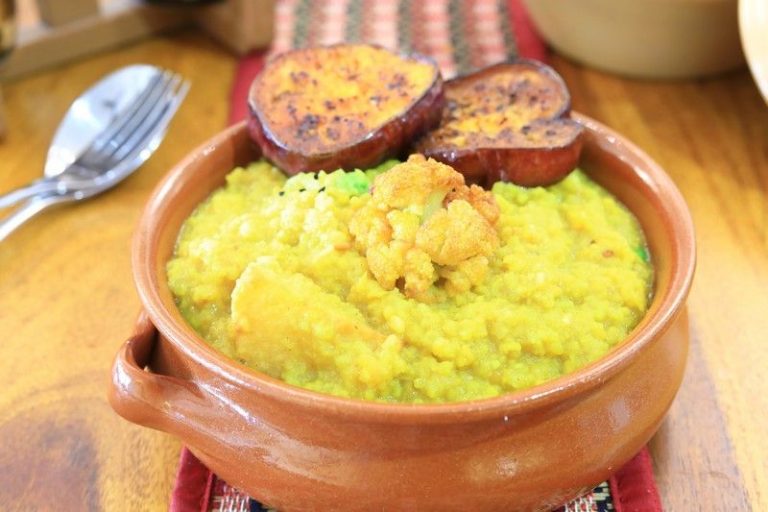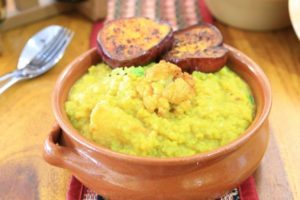Picture this – it’s a cloudy afternoon, lightning and thunder accompany an intermittent rain – which at times, lashes, and at others, heavily drizzles. The wind sways the raindrops – angling toward you and away sometimes. The fragrance of petrichor engulfs your senses, as you suddenly feel a gentle rumble in your belly.
What food do you turn to?
Now, imagine this. You’re running late to get to work – the plumbing was an issue. Your spouse is taking care of the kids, feeding them breakfast while the school bus is only 20 minutes away. There’s a presentation that you need to go over before that meeting at 10 AM; yet you can’t let your kids go to school without a lunchbox.
It goes with aloo bhaja, just as cohesively as begun bhaja. You could have it with “Joda Ilish, Maach Bhaja, Beguni, Maacher Dimer Bora or dimer bhaja”, or you could add some “phoolkopi”. You’re relishing it on a Tuesday night with some papad, you eat it as a pick-me-up, you eat it for comfort.
“Khichuri” – the name inspires hunger. Not gluttony; hunger. It’s supposed to be treated with respect, because it reciprocates. As versatile as the late great Soumitro Chatterjee, Khichuri occupies a special place in the hearts and bellies of our Bengali brethren. It’s Bengal’s go-to dish with no qualms whatsoever, revered so much that it’s the only constant in the “bhog” we get during Pujo. Humble in its preparation and ingredients; yet it’s the most delectable rice preparation in our cuisine.
Back in November 2017, when Indian netizens were busy debating the possibility and candidacy of regional preparations as India’s “national dish”, only one name cropped up from multiple states. Khichuri (also known as khichdi, khichda, khisiri, Pongal, Bisi bele bath, pulagam, Haleem and kedgeree) is available EVERYWHERE, but no two khichuri preparations are the same. Even within Bengal, this delightful mish-mash of rice and lentils maintains its individuality while being comprised of the two MOST staple elements of the Indian kitchen.
The “Sona Mung Khichuri” holds a special place in many Bengalis’ lives. During Pujo – Durga, Saraswati or Lokkhi – this variant is offered as the scene-stealing showstopper that hundreds of us wait for with bated breath. The Bhuni Khichuri, Mosoor Dal Khichuri, or the Arhar dal-er khichuri, are all variations of this enigmatic preparation – making moms happy everywhere. Just like Shukto, the khichuri’s versatility showcases the diversity of Bengal as a state – Divided by ingredients, United by Khichuri.
The fact that Khichuri is called by a gamut of names all over India shows us its history, availability and prominence in other cuisines also. Originating in present-day Bihar, the khichuri has been eaten as a family-favorite in gatherings as far as Tamil Nadu. The Mughal Empire gave it a whole new spin. Jehangir preferred a hearty bowl of khichdi on meat-less days. It was called “Lazizan”, and was prepared with raisins, spices and pistachios in ghee. The personal chefs of the king of Awadh created a special khichdi made entirely with almonds and pistachios, shaped to look-like rice and lentils.
In Marathi literature, a very famous and popular short story (akin to King David and the spider’s story) is this anecdote from Chhatrapati Shivaji’s life. He went through a sequence of defeats, when he took shelter at a carpenter’s house in disguise. The wife gave him a serving of hot khichdi. Shivaji – distracted at his dismay – unknowingly placed his finger right through the middle and got singed. She said, “Oh, brave soldier, you are just like your king. You start from the inside first. Just like he attacks kingdoms instead of the periphery, you are eating this hot khichdi inside-first. Why don’t you try to eat the corners first and then attack the centre?” Shivaji realised his mistake — and learnt a strategic battle lesson. The rest is history. Shivaji led the Maratha Empire towards greatness; all inspired by a steaming, hot and nutritious bowl of khichuri.
Bengali by nature however, our khichuri is a lot more inspirational for the tummy, and we’re not going to let it rumble anymore. Here’s the recipe:
WHAT YOU’LL NEED:
(4 servings of Khichuri)
- The Absolute Essentials
- 1 cup basmati rice or govind bhog rice
- 1 cup roasted moong dal
- 1 tablespoon Ghee or 2 tablespoon mustard oil
- 6 cups water
- The Spices
- 1 tej patta (indian bay leaf)
- 1 teaspoon Bengali 5 spice
- 1 inch grated ginger
- ½ teaspoon turmeric powder
- ½ teaspoon wild celery
- Few bay leaves
- The Vegetables
- 1 green chili, chopped
- 2 small to medium potatoes,
- ½ cauliflower and
- ½ cup green peas
THE RECIPE:
- Heat mustard oil and fry the potato wedges marinated in turmeric n salt
- Add the marinated cauliflower in the balance oil and pan roast
- Add grated ginger and chilli, saute for a 5-6 seconds or till the raw aroma of the ginger goes away.
- Take another wok , add 1 spoon of ghee and splutter the 5 spice and bay leaves
- Add drained rice and saute for 1 minute until raw smell goes away
- Add roasted and washed moong dal.
- Pour 5 cups water and add salt & sugar.
- Cover and cook until rice and moong dal is 80 percent cooked
- Add the vegetable cooked in slow steam and leave it to blend the aromas of rice dal and vegetable
- Finally add 1 spoon of ghee and paste of wild celery.
- Serve the khichuri with whichever side rocks your boat the hardest.
In our second blog of the “Niramish” series, we wanted to bring you as close to Khichuri as humanly possible. The ONLY possible next step is to order it off our menu. Even better, we recommend listening to a Soumitro-Suchitra song as you savor one of our most popular delicacies. Take it from Mr. Kuntal Maitra, we completely agree with his assessment.




